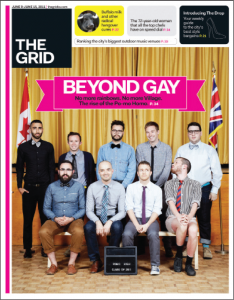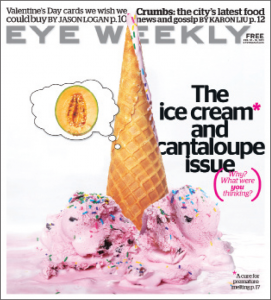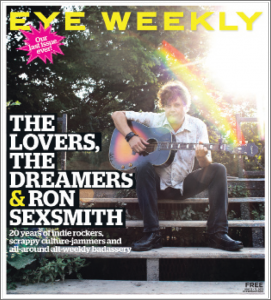Lost in The Grid
Torstar and Laas Turnbull have a bold vision: create a new style of weekly that captures the pulse of Toronto's communities. But eight months in, The Grid is still searching for its own editorial heart and soul
 It all started with a lighter. In the dog days of August, one of The Grid’s senior editors sparked an ironic hashtag in the twittersphere: #UnfriendlyToronto. Edward Keenan was on a city beach with his wife and two children when a six-year-old boy came over to borrow a lighter for the candles on his brother’s birthday cake. When Keenan obliged, the boy’s mother invited his family to join the party, and they spent a lovely afternoon talking bikes and kids with perfect strangers.
It all started with a lighter. In the dog days of August, one of The Grid’s senior editors sparked an ironic hashtag in the twittersphere: #UnfriendlyToronto. Edward Keenan was on a city beach with his wife and two children when a six-year-old boy came over to borrow a lighter for the candles on his brother’s birthday cake. When Keenan obliged, the boy’s mother invited his family to join the party, and they spent a lovely afternoon talking bikes and kids with perfect strangers.
The same week, Toronto Life came out with its “Exodus to the Burbs” issue. The cover story, by Philip Preville, described young families fleeing the city for small towns and characterized Toronto as a place where residents “don’t make eye contact, don’t eavesdrop, don’t assume someone else is watching the kids.” Irked by the piece and inspired by his beach encounter, Keenan published a rebuttal online. Then Grid readers shared similar experiences on Twitter and tagged the anecdotes #UnfriendlyToronto.
The hashtag quickly went viral as Torontonians described neighbours who lent out pearls for weddings, ran out the door to hand umbrellas to a kid waiting for the bus in the rain and raised money for a local woman’s medical supplies. The cover of The Grid that week featured a row of monotonous houses. The headline? “Dear Toronto Life, This Is What a Suburb Looks Like.” As far as The Grid was concerned, the monthly could keep its urban exodus and leave documenting what a city really looks like up to the design-heavy free weekly.
The Grid is something of a gamble for Star Media Group. The media conglomerate’s president,Toronto Star publisher John Cruickshank, hired Laas Turnbull as publisher and editor-in-chief of Eye Weekly based on Turnbull’s vision of a new free paper. Cruickshank is betting on his ability to grab the attention of a group of readers in transition: an audience that no longer searches for the next “it” bar on blogs, doesn’t connect with alt-weekly now’s countercultural ethos and feels alienated by Toronto Life’s aspirational tone. With Turnbull at the helm, The Grid is attempting to combine great design with blog-style community content, intelligent civic criticism and tastemaking lifestyle pieces. It’s a radical departure from the traditional alt-weekly modus operandi, and that’s why the paper has dropped the alternative label and wants to become something more akin to a magazine, but in a free weekly format.
Named after the layout of Toronto’s streets, The Grid hopes to capture what deputy editor Lianne George describes as a “moment” in the city. That moment is the synthesis of civic frustration (inspired by mayor Rob Ford) and cultural excitement (mostly a burgeoning culinary movement). “If someone who’s recently arrived in Toronto picks this up, I think they’re going to feel like they’re learning something about the city,” says staff writer Matthew Halliday. Unfortunately, that doesn’t always work for people who have been kicking around for a while. Toronto-based novelist Zoe Whittall tweeted that Turnbull’s brainchild is “a tourism magazine for people who live here.”
The documentary-style photography, popular local columnists and blog-inspired community content make for skimmable but inviting reading. “I don’t think I’ve ever seen Eye Weekly or even NOW in the hands of so many people when I’m walking around downtown,” says former Torontoist editor David Topping, who has since begun writing for The Grid. “It’s just a really good package.” So far, though, the paper’s editorial product doesn’t always live up to its slick packaging.
 When then Torstar publisher John Honderich and VP of sales Andrew Go took NOW owners Michael Hollett and Alice Klein out for lunch in 1991, they didn’t just pick up the tab—they offered to buy the pair’s successful alternative paper. After Klein and Hollett refused the offer, Torstar launched Eye Weekly with 20 staff crammed into a tiny office, deliberately across town from “the mothership,” the Toronto Star. A corporate mouthpiece with indie sensibilities, Eyenever really fit into what National Post writer Daniel Kaszor calls “the big caviar communist family” of alt-weeklies.
When then Torstar publisher John Honderich and VP of sales Andrew Go took NOW owners Michael Hollett and Alice Klein out for lunch in 1991, they didn’t just pick up the tab—they offered to buy the pair’s successful alternative paper. After Klein and Hollett refused the offer, Torstar launched Eye Weekly with 20 staff crammed into a tiny office, deliberately across town from “the mothership,” the Toronto Star. A corporate mouthpiece with indie sensibilities, Eyenever really fit into what National Post writer Daniel Kaszor calls “the big caviar communist family” of alt-weeklies.
Like many corporate-owned alts, Eye’s strength was arts and entertainment. In 1992, inspired by a stunt pulled by British magazine Q, staffers invented a band called The Obvious. A freelance writer, the production guy, a friend of the editor and some other dude posed for an official eight-by-ten glossy photo, which music writer Laura Lind put with a one-page bio and a cassette tape and then hand-delivered to A&R reps at 18 record companies. One rep called two hours later—his copy wouldn’t work. None of them did, of course. The tapes were all blank. But that didn’t stop 12 reps from claiming they had listened to it when Lind placed follow-up calls posing as a manager. When Eye published “Sound of Silence” about the stunt it earned the loyalty of the music community. In the early 2000s, with the indie rock explosion led by local collective Broken Social Scene, the paper graduated from cheeky troublemaker to cheerleading gatekeeper to the scene.
But before the end of the decade, things changed. Stuart Berman, who has been with the paper since 2000, says the internet and mainstream attention to indie culture siphoned readers from Eye’s arts-heavy coverage. Keenan, who has been with the paper since 2002, agrees: music fans turned to sites such as Pitchfork , and mainstream publications started covering the scene Eye had captured so well. “We saw a lot of what we thought of as our role, and the need for it, eroding slowly,” Keenan says. Whatever claim to alternative Eye had was gone, and when Turnbull came on board in August of 2010, he decided to drop the label and go for a different demographic. The last Eye cover featured local singer-songwriter Ron Sexsmith bathed in syrupy sunlight.
“Now, what we’re doing with food is very reminscent of what we did with music,” says Berman. The emphasis on all things culinary is a reflection of both a cultural shift in the city and Turnbull’s own passion. “He sends me food pictures all the time,” says staff writer Karon Liu, who was hired in part because he’s so tapped in to the food scene. Showcasing writers with niche expertise is one of a few ideas Turnbull has incorporated from Eye’s past (another is strong columnists, which appeals to advertisers as well as readers). But he is quick to point out his paper is its own publication, and he’s hoping to eclipse the past and move on. “By hiring Laas, you’re not hiring somebody who’s going to stay the course. You’re getting somebody who’s going to totally transform something and put his mark on it,” says parenting columnist Christopher Shulgan. “He is very, very smart. He’s very, very competitive, and he’s a good guy to be leading something that you’re a part of.”
A veteran of Shift, Maclean’s and Toronto Life, Turnbull has been gunning for a publisher’s chair since he dropped out of journalism school in the early ’90s. In 2002, he became editor atReport on Business magazine. His plan? Dress up a consumer business title as a general interest magazine. It worked. Under Turnbull’s leadership, Report on Business amped up the personality and style and won several National Magazine Awards, its first in two years. He focused on the design: the art direction, front of book and photography improved. After ROB, Turnbull served as executive vice president at Brunico Communications, which publishes trade mags such as Strategy and Media in Canada. Here, he learned more about the business side of publishing. Turnbull’s ambition is no secret in media circles, and whether it was confidence or cockiness, his faith in his new product was evident in the lead-up to the launch when he made it clear he was going after Toronto Life’s readers—and its ad dollars.
“Toronto Life, they have 50 reasons to like Toronto or whatever, but I’m never quite convinced,” says Halliday. In The Grid offices, they’re happy to run with the David and Goliath narrative. Toronto Life’s editorial missteps, such as “Exodus to the Burbs,” have bolstered that myth. That article was indicative of what one of the magazine’s own freelancers calls an identity crisis. He says even staff have been questioning editorial decisions that seem more stodgy than innovative. “They’re also experiencing a serious brain drain,” he says. At the beginning of the summer, publisher Sharon McAuley and art director Jessica Rose left the title. As well, Liu and Carley Fortune migrated to The Grid.
The new talent has infused energy into the paper, which was limping along with a skeleton staff before Turnbull arrived. “Jokes were about how we were all about to get fired, and how we were all about to be on the street,” says former staff writer and current contributor Kate Carraway of the gallows humour. “Being revitalized in the way that it was just felt like a dream.”
The Grid has also rethought the locations of the old Eye newspaper boxes, removing them almost entirely from suburban areas. Now, distribution is concentrated downtown where targeted readers live. Those readers are more likely to drink coffee bearing the name of award-winning barista Sam James than Tim Horton, but Liu says they look for buzz restaurants where a meal for two costs less than $80 with booze.
And they want to be able to leave the weekly paper lying around without worrying about a toddler opening up a page of sex ads. Glossies are now the main competition and the rivalry with alts is out—so The Grid is gladly surrendering the escort ads to NOW. Those raunchy back pages are a huge source of revenue for free weeklies, but Cruickshank makes flinty eye contact from behind his tortoiseshell glasses to say, with no hint of regret, that they don’t fit with the Torstar brand.
 The decision to ditch the escort ads is significant. The paper wants to capture Toronto “at street level,” but it’s a carefully selected street. Sex at The Grid is tongue-in-cheek dating stories, burlesque dancers peeking from beneath bowler hats, erotic portraiture, a think piece about a young man’s sexual freedom. Gone is the sophomoric, freewheeling edge that traditionally characterizes a free weekly. It’s less the angry kids smoking behind the bleachers and more the yearbook club’s perky enthusiasm.
The decision to ditch the escort ads is significant. The paper wants to capture Toronto “at street level,” but it’s a carefully selected street. Sex at The Grid is tongue-in-cheek dating stories, burlesque dancers peeking from beneath bowler hats, erotic portraiture, a think piece about a young man’s sexual freedom. Gone is the sophomoric, freewheeling edge that traditionally characterizes a free weekly. It’s less the angry kids smoking behind the bleachers and more the yearbook club’s perky enthusiasm.
The Grid wants to tap into Toronto’s neighbourhoods, which isn’t just good for readers; it’s good for advertisers and an important part of the online strategy. Thegridto.com features a Neighbourhoods section with separate pages for every corner of the city. This might be a way to compete with now’s lock on the local business owner’s advertising dollars. Bolstering the online presence also allows a print product to package contests into its advertising more easily. In August, the site received 225,000 unique page views and 650,000 page views in total. For the print incarnation, the paper cut the run from 110,000 to 80,000, but according to researchThe Grid commissioned through the Angus Reid Forum, an online market research panel, within eight weeks of the May relaunch, it went from two readers per copy to three. And the publication has the industry talking.
Turnbull isn’t, though. His response to interview requests is friendly, but firm: Talk to my writers and editors, talk to my boss, hang around the offices as much as you like, but when it comes to my final word, I’d prefer people get it by picking up the paper, not knocking on my door.
Either way, NOW’s Hollett isn’t worried. “The Grid is the absolute latest in a million attempts across North America to do the complete misguided dream of big business media,” he says. “Their fantasy is that the world is waiting for alt-weeklies lite. And you know what? They’re not.”
At a Tuesday morning production meeting on the second floor of the Star building, art director Vanessa Wyse leans over the IKEA table and scoops up three empty wine bottles. “We don’t usually drink at our morning meeting,” jokes George. “Sometimes, but not often.” As the lake reflects the sunlight beyond the wall-to-wall windows, the staff gravitate toward the table, pulling chairs behind them. Seth Rogen’s bespectacled face watches over the quiet office. Pinned side by side, the covers of NOW and Cineplex feature the same stock photo of the Canadian-born actor. Flanking the otherwise empty bulletin board are giant posters of recentGrid photos.
Galleys in front of them, the team sits down to put the final touches on the book. Someone makes a joke about the Ontario Green Party’s new ad campaign featuring a nine-year-old girl in a pantsuit. “Child labour!” one staffer cries and everyone chuckles. After a few concerns over lack of content, some notes on the production pages, a quick back and forth on styling credits for a spread on dressing like a nonchalant celebrity, the meeting ends. The team works like a many-headed creature—there’s a definite rhythm as they finish one another’s sentences and change tack quickly as soon as George vetoes something. If this office ever saw the belligerent, passionate defence of ideas that is such a big part of alt-weekly lore, it’s long gone.
Infused with new money, talent and vision, The Grid hopes to create a climate of urban optimism, but not at the expense of civic dialogue. It’s as unafraid to criticize local government, regardless of party lines, as it is to celebrate the place it calls home. In his rebuttal to theToronto Life piece, Keenan wrote, “I could fill a shelf of books with little stories like the one I just described.” In another column, however, he was eager to call utopian dreaming at city hall to task: “Despite what we’d all like to believe, you cannot build a city for free.”
When Turnbull and George took over, observers were surprised Keenan stayed, since he was effectively demoted to make room for the new team. Keenan went into Turnbull’s office, half expecting to be fired, and walked out with the same title and a job description that, he says, had far more appeal. With more time to concentrate on writing, his urban affairs pieces are some of the best work in the paper. Keenan’s insider knowledge of city hall translates the circus of metropolitan politics into intelligent, unbiased criticism while capturing the vivid characters and telenovela-esque levels of personal antagonism between the city’s civic leaders. His profile of Giorgio Mammoliti, a colourful councillor who has proven to be a political shape-shifter, introduced readers to “The Thumb,” which Mammoliti uses to direct the mayor’s allies on votes. A more recent piece outlined five ways the mayor could save his sinking policy strategy without losing face with supporters.
Still, many other features are tame: “49 Totally Rad Things to Do with Your Kid in the City,” for example, or “Like a Boss,” a flat feature on affluent young people who started their own businesses. And packages such as “86 Excuses to Drink Now” seem more typical of a blog. As a weekly, the paper has to find new ways to approach stories that might be a few days old. So good packaging is crucial. Photo features and infographics make up the bulk of the paper’s anatomy, but there are other graphic choices, such as tiny maps that ground articles on a specific street corner. “There’s a kind of disease infecting magazine journalism these days, in my view, and it’s over-packaging,” says one magazine editor, flipping through a copy of The Grid. He pauses at a flow chart outlining restaurant suggestions for Father’s Day. “I don’t get this,” he says. “You can stare at it for two minutes, but people don’t. There’s not a lot of journalism in this publication.” The trick is executing packages so readers don’t have to figure them out.
That execution rests on the shoulders of George. In her early 30s, she has a spare and tidy office, but she’s constantly apologizing for the state of it. She rarely blinks, making her seem supernaturally aware. “She’s a very nice, very personable woman who works her ass off and has an anarchist’s sensibility,” says Shulgan. In 2000, Turnbull hired her as an intern at Shift. Since then, she’s worked as a senior editor at Maclean’s and as deputy editor through a relaunch at Canadian Business. She and Turnbull have a similar editorial approach. “Lianne’s a package person,” says former Grid senior editor David Fielding.
 The cover of the first issue featured a grainy portrait of Jen Agg and Grant Van Gameren, then-owners of the trendy charcuterie restaurant the Black Hoof. The centre spread, which required wrangling 35 top culinary figures to an Easter Monday photo shoot on two days’ notice, played on the notion of accessibility. Thanks to a little studio magic, the men and women behind some of the most exclusive spots in the city sat on a curb eating street meat. It was ambitious, outlandish—and it worked.
The cover of the first issue featured a grainy portrait of Jen Agg and Grant Van Gameren, then-owners of the trendy charcuterie restaurant the Black Hoof. The centre spread, which required wrangling 35 top culinary figures to an Easter Monday photo shoot on two days’ notice, played on the notion of accessibility. Thanks to a little studio magic, the men and women behind some of the most exclusive spots in the city sat on a curb eating street meat. It was ambitious, outlandish—and it worked.
But there have been a few bumps since then, like a misleadingly packaged June feature by Paul Aguirre-Livingston entitled “Dawn of a New Gay.” The think piece about “Post-modern Homos,” a generation of young men who feel they no longer need the gay rights movement, fit with what former writer Sarah Nicole Prickett calls The Grid’s “emptily provocative new agenda.” The response from critics within the gay community was immediate and angry. Within a day, 500 people—many questioning the narrowness of the argument—had commented on the website; that was 12.5 percent of the comments it received in the first six months in one day. “I thought it showed a serious lack of both hindsight and foresight on the publisher’s part,” Prickett says. “Truly a mind-blowingly stupid decision that was not ameliorated by a defensive non-apology.”
Elie Chivi was one of nine young men on the cover of the “Dawn of a New Gay” issue. “It wasn’t an educated look at our community. It was more of a privileged look,” says Chivi, who grew up in the Middle East, studied in Montreal and moved to Toronto in 2010. The Gridemailed him a short blurb describing the piece as covering “the new generation of gays who feel they shouldn’t be so radically defined by their sexual orientation.” After the issue came out, Chivi wrote a scathing response on Montreal blog The Gaily. As someone who is no stranger to a culture of oppression, he resented The Grid using his photo to represent a reality that is far from his. “Thanks to Will & Grace and Britney Spears, it’s all fine and dandy? That to me was really a slap in the face.”
The problems with the feature contributed to Prickett’s decision to leave The Grid. “I composed an email to the publisher containing the words ‘embarrassing parody of whiteness,’ but never sent it,” she writes in an email. “Maybe because I looked at myself in the mirror.”
Eight of the nine young men featured on the “Beyond Gay” cover were white; Chivi was the only exception. The masthead, as well, is almost entirely white. When the mission is to cover Toronto, that weakness is telling—and it shows up on the page. The paper has run precious little journalism, beyond streeters, featuring black Torontonians. Coverage of the South Asian community has been more robust, with a story on the people behind a popular Indian restaurant, a Bollywood Oscars cover and a Toronto Internatonal Film Festival spread starring comedian Russell Peters. All of the ambitious packages, from the chefs and mixologists to a piece on young entrepreneurs, have been predominantly, if not entirely, white. The Grid’s lack of diversity is surprising given that Turnbull made eliminating that kind of narrow coverage one of his goals at rob. This may be another part of the learning curve. The art for a November cover story featured an ethnically diverse group of LGBTQ young people and their allies, suggesting The Grid is widening its view to represent the city as a whole. Still, the cover featured the one white portrait.
“We’re trying to invite everyone into the conversation,” says George. But lack of staff diversity has long been an issue for weeklies, says Charles Whitaker, a research chair at Northwestern University’s Medill Journalism School and veteran of Chicago’s black community paper, Ebony. He says the lack of diverse coverage is a bigger problem than the lack of diverse staff. But, he says, “It is up to the community to decide that a publication’s narrow coverage is unacceptable.”
Community loyalty is the rogue variable in Turnbull’s carefully crafted strategy. Cruickshank says the vision that scored him the job “really has to do with creating a publication that digs in and understands what’s great and not so great about the community that we live in.” In his response to Toronto Life, Keenan wrote, “The downtowner’s ideal [is] rooted in the nostalgia for what they imagine a ‘real’ human-scale community…looks like.” This is the city The Grid wants to reflect, but with a smaller lens comes exclusion, and as the paper approaches its first birthday, its challenge will be to bring together Toronto’s community sensibility with its cultural scope—in a good-looking package, naturally.
Haley Cullingham was the Editor of the Winter 2012 issue of the Ryerson Review of Journalism.














































